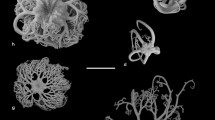Summary
Tridactylous, trifoliate, and globiferous pedicellariae occur on the body surface of Echinocardium cordatum. Tridactyles have three forms: the typical, the rostrate, and the large forms. Both typical and rostrate tridactyles and trifoliates occur all around the echinoid body (trifoliates are, however, 4 times more numerous than tridactyles). Large tridactylous and globiferous pedicellariae are restricted to the peribuccal area.
As a general rule tridactyles and trifoliates are similar in morphology. The distal part of the valves forms an open blade and bears lateral teeth and/or denticles (single or in combs). The stalk consists of a rigid proximal part supported by an axial rod and a flexible distal part which includes an axial fluid-filled cavity. The cavity is surrounded by muscle fibers and acts as an hydroskeleton, allowing the undulating-coiling movements of the flexible part of the stalk. Trifoliates are always active while tridactyles react only to direct or indirect mechanical stimulation.
The valves of the globiferous pedicellariae have a tubular distal part whose upper opening is surrounded by teeth. There is no differentiated venom gland but a cluster of epithelial glandular cells located at the level of the valve upper opening. A small ciliary pad occurs just below the glandular cluster. Globiferous stalks are not flexible, being supported for their full length by an axial rod. Globiferous pedicellariae appear to be sensitive only to chemical stimulation.
The presumed functions of E. cordatum pedicellariae are (1) cleaning of the body surface and ciliary structures (trifoliates), (2) protection against sedimenting particles (tridactyles), and (3) defense of the peribuccal area against potential small predators (globiferous pedicellariae).
Similar content being viewed by others
References
Campbell AC (1972) The form and function of the skeleton in pedicellariae from Echinus esculentus L. Tissue Cell 4:647–661
Campbell AC (1973) Observations on the activity of echinoid pedicellariae: I. Stem responses and their significance. Mar Behav Physiol 2:33–61
Campbell AC (1976) Observations on the activity of echinoid Pedicellariae: III. Jaw responses of globiferous pedicellariae and their significance. Mar Behav Physiol 4:25–39
Campbell AC (1983) Form and function of pedicellariae: A review, Vol 1. In: Jangoux M, Lawrence JM (eds) Echinoderm studies. Balkema, Rotterdam, pp 139–167
Campbell AC, Laverack MS (1968) The responses of pedicellariae from Echinus esculentus L. J Exp Mar Biol Ecol 2:191–214
Campbell AC, Rainbow PS (1977) The role of pedicellariae in preventing barnacle settlement on the sea-urchin test. Mar Behav Physiol 4:253–260
Cannone AJ (1970) The anatomy and venom-emitting mechanism of the globiferous pedicellariae of the urchin Parenchinus angulatus (Leske) with notes on their behaviour. Zool Afr 5:179–190
Chia FS (1969) Histology of the pedicellariae of the sand dollar Dendraster excentricus (Echinodermata). J Zool Lond 157:503–507
Chia FS (1970) Histology of the globiferous pedicellariae of Psammechinus miliaris (Echinodermata: Echinoidea). J Zool Lond 160:9–16
Cobb JLS (1968a) The fine structure of the pedicellariae of Echinus esculentus L. I. The innervation of the muscles. J R Microsc Soc 88:211–221
Cobb JLS (1968b) The fine structure of the pedicellariae of Echinus esculentus L. II. The sensory system. J R Microsc Soc 88:223–233
Döderlein L (1906) Die Echinoiden der deutschen Tiefsee-Expedition. Wiss Ergeb Dtsch Tiefsee-Exped 5:63–290
Ganter P, Jollès G (1969/1970) Histochimie normale et pathologique, 2 vols. Gauthier Villars, Paris, pp 1–1904
Hilgers H, Splechtna H (1976) Struktur- und Funktionsanalyse ophiocephaler Pedizellarien von Sphaerechinus granularis (Lam.), Echinus acutus Lam. und Paracentrotus lividus (Lam.) (Echinodermata, Echinoidea). Zoomorphologie 86:61–80
Hilgers H, Splechtna H (1982) Zur Steuerung der Ablösung von Giftpedizellarien bei Sphaerechinus granularis (Lam.) und Paracentrotus lividus (Lam.) (Echinodermata, Echinoidea). Zool Jahrb Abt Anat Onto Tiere 107:442–457
Holland LZ, Holland ND (1975) The fine structure of epidermal glands of regenerating and mature globiferous pedicellariae of a sea urchin (Lytechinus pictus). Tissue Cell 7:723–737
Jensen M (1966) The responses of two sea-urchins to the sea star Marthasterias glacialis (L.) and other stimuli. Ophelia 3:209–219
Koehler R (1927) Les échinodermes des mers d'Europe, Vol. 2. Doin, Paris, pp 339
Lambert A, De Vos L, Jangoux M (1984) Functional morphology of the pedicellariae of the asteroid Marthasterias glacialis (Echinodermata). Zoomorphology 104:122–130
Mendes EG (1965) The pedicellariae and the settling of pelagic larvae of sessile animals on sea urchins. An Acad Bras Cienc 37 [Suppl]:215–219
Mortensen Th (1951) A Monograph of the Echinoidea. V.2 Spatangoida II. Reitzel, Copenhagen, pp 593
Oldfield SC (1975) Surface fine structure of the globiferous pedicellariae of the regular echinoid, Psammechinus miliaris Gmelin. Cell Tiss Res 162:377–385
Oldfield SC (1976) The form of the globiferous pedicellarial ossicles of the regular echinoid, Psammechinus miliaris Gmelin. Tissue Cell 8:93–99
Ramsay RE, Campbell AC (1985) An investigation of the distribution of pedicellariae in Echinus esculentus L. In: Keegan BF, O'Connor BDS (eds) Echinodermata. Balkema, Rotterdam, pp 315–320
Splechtna H, Hilgers H (1980) Rasterelektronen- und lichtoptische Untersuchungen an den Pedizellarien von Arbacia lixula L. In: Jangoux M (ed) Echinoderms: present and past, Balkema, Rotterdam, pp 79–84
Uexküll J von (1899) Die Physiologie der Pedicellarien. Z Biol 37:334–403
Author information
Authors and Affiliations
Rights and permissions
About this article
Cite this article
Ghyoot, M., De Ridder, C. & Jangoux, M. Fine structure and presumed functions of the pedicellariae of Echinocardium cordatum (Echinodermata, Echinoida). Zoomorphology 106, 279–288 (1987). https://doi.org/10.1007/BF00312002
Received:
Issue Date:
DOI: https://doi.org/10.1007/BF00312002




